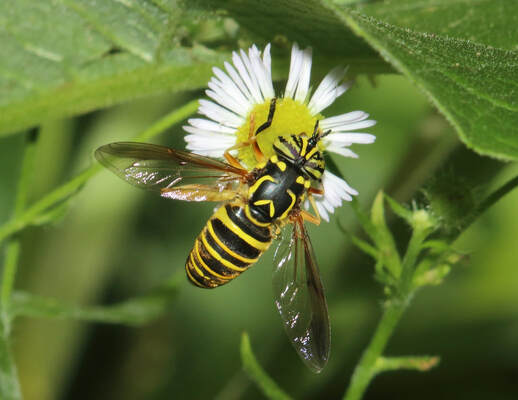 A flower fly, Spilomyia longicornis. Photo by VMN volunteer Bruce Grimes.
A flower fly, Spilomyia longicornis. Photo by VMN volunteer Bruce Grimes.
On June 20, 2014, President Obama issued a Presidential Memorandum instructing federal agencies to work to protect the health of pollinators on federal lands. It is difficult to protect what one does not know one has, so in 2015, the Blue Ridge Parkway, assisted by the Appalachian Highlands Science Learning Center (AHSLC), launched the first of a series of pollinator inventories to better understand the distribution and habitat use of pollinators along the length of the Parkway, recruiting community scientists to collect most of the samples.
Flies of the family Syrphidae (a.k.a. hover flies or flower flies) may be second only to native bees as important pollinators of native plants. There are over 6,300 described species in this family world-wide and about 288 species that possibly occur along the Blue Ridge Parkway. This family includes small to large flies, many of whom are excellent mimics of bumblebees, yellow jackets, honeybees, and wasps, though some look more like small house flies. In addition to adult flower flies pollinating flowers, some flower fly larvae help decompose logs or improve water quality in ponds and wetlands. Some larvae even feed on ant larvae, aphids, or fresh tree sap. The adult flies do not bite nor can they sting, but some of the mimic species not only look like a bee or wasp but mimic the flight patterns, behavior, and buzz of the bee or wasp they are modeling.
A project conducted by the lab of Dr. Jenni Geib of Appalachian State University in 2019 to inventory native bees produced many flower fly specimens as by-catch. At the same time, the Field Guide to the Flower Flies of Northeastern North America (Skevington et al., 2019) was published, making it possible for naturalists with some entomological training to identify this group to species for the first time. Thus in 2020, the Parkway and AHSLC launched a pilot study to inventory flower flies with the goal of developing a species list for the Parkway and to begin to understand the distribution and hot-spots for these flies. The pandemic put this effort on hold before field work really got started, but it was relaunched in 2021 (BLRI-2021-SCI-0011) and successfully completed in November, with the assistance of the lab of Dr. Geib. Community science volunteers were recruited from the Virginia Master Naturalist Program and from a group of known volunteers who had worked on previous biodiversity inventory projects.
During 2021, five Virginia Master Naturalists made over 30 visits to sites along the Blue Ridge Parkway to assist with this flower fly inventory. Together they identified 35 species, four of which were not identified by others working on this project. All told, 1,000 specimens have been examined to date, and 66 taxa have been documented along the Parkway, with more expected as students at Appalachian State University finish sorting through specimens picked up by the 2019 native bee inventory project that Virginia Master Naturalists also assisted on. A few of the taxa can clearly be designated as representing a “new species” for the Parkway.
The flower fly project may continue in 2022 and there may be sections of the Parkway where we will need help. Contact Paul Super if you are a VMN located near the Blue Ridge Parkway and would like to volunteer for this effort.
